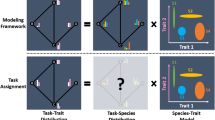Abstract
This paper addresses team formation in the RoboCup Rescue centered on task allocation. We follow a previous approach that is based on so-called extreme teams, which have four key characteristics: agents act in domains that are dynamic; agents may perform multiple tasks; agents have overlapping functionality regarding the execution of each task but differing levels of capability; and some tasks may depict constraints such as simultaneous execution. So far these four characteristics have not been fully tested in domains such as the RoboCup Rescue. We use a swarm intelligence based approach, address all characteristics, and compare it to other two GAP-based algorithms. Experiments where computational effort, communication load, and the score obtained in the RoboCup Rescue aremeasured, show that our approach outperforms the others.
Similar content being viewed by others
Explore related subjects
Discover the latest articles, news and stories from top researchers in related subjects.References
Agassounon, W., & Martinoli, A. (2002). Efficiency and robustness of threshold-based distributed allocation algorithms in multi-agent systems. In Proceedings of the first international joint conference on autonomous agents and multiagent systems, AAMAS 2002 (pp. 1090–1097). New York, NY, USA: ACM.
Bonabeau E., Theraulaz G., Dorigo M. (1999) Swarm intelligence: From natural to artificial systems. Oxford University Press, New York, USA
Cicirello V., Smith S. (2004) Wasp-like agents for distributed factory coordination. Journal of Autonomous Agents and Multi-Agent Systems 8(3): 237–266
Ferreira P. R. Jr., Boffo F., Bazzan A. L. C. (2008) Using swarm-GAP for distributed task allocation in complex scenarios. In: Jamali N., Scerri P., Sugawara T. (eds) Massively multiagent systems, volume of 5043 in lecture notes in artificial intelligence. Springer, Berlin, pp 107–121
Ferreira P. R. Jr., dos Santos F., Bazzan A. L. C., Epstein D., Waskow S. J. (2010) Robocup Rescue as multiagent task allocation among teams: Experiments with task interdependencies. Journal of Autonomous Agents and Multiagent Systems 20(3): 421–443
Ham M., Agha G. (2007) Market-based coordination strategies for large-scale multi-agent systems. System and Information Sciences Notes 2(1): 126–131
Ham M., Agha G. (2008) A study of coordinated dynamic market-based task assignment in massively multi-agent systems. In: Jamali N., Scerri P., Sugawara T. (eds) Massively multiagent systems, volume of 5043 in lecture notes in artificial intelligence. Springer, Berlin, pp 43–63
Hölldobler B. (1983) Territorial behavior in the green tree ant (Oecophylla smaragdina). Biotropica 15(4): 241–250
Hölldobler B., Stanton R. C., Markl H. (1978) Recruitment and food-retrieving behavior in Novomessor (formicidae, hymenoptera). Behavioral Ecology and Sociobiology 4(2): 163–181
Hunsberger, L., & Grosz, B. J. (2000). A combinatorial auction for collaborative planning. In Proceedings of the fourth international conference on multiAgent aystems, ICMAS (pp. 151–158). Boston.
Kitano, H., Tadokoro, S., Noda, I., Matsubara, H., Takahashi, T., Shinjou, A., & Shimada, S. (1999). Robocup Rescue: Search and rescue in large-scale disasters as adomain for autonomous agents research. In Proceedings of the IEEE international conference on systems, man, and cybernetics, SMC (Vol. 6, pp. 739–743) Tokyo, Japan: IEEE.
Krieger M. J. B., Billeter J.-B., Keller L. (2000) Ant-like task allocation and recruitment in cooperative robots. Nature 406(6799): 992–995
Kube R., Bonabeau E. (2000) Cooperative transport by ants and robots. Robotics and Autonomous Systems 30(1/2): 85–101 ISSN: 0921-8890
Rahwan T., Jennings N. R. (2007) An algorithm for distributing coalitional value calculations among cooperating agents. Artificial Intelligence Journal 171(8–9): 535–567
Robson S. K., Traniello J. F. A. (1998) Resource assessment, recruitment behavior, and organization of cooperative prey retrieval in the ant Formica schaufussi (hymenoptera: Formicidae). Journal of Insect Behavior 11(1): 1–22
Santos, F. D., & Bazzan, A. L. C. (2009). eXtreme-ants: Ant based algorithm for task allocation in extreme teams. In N. R. Jennings, A. Rogers, J. A. R. Aguilar, A. Farinelli, & S. D. Ramchurn (Eds.), Proceedings of the second international workshop on optimisation in multi-agent systems (pp. 1–8). Budapest, Hungary, May.
Scerri P., Farinelli A., Okamoto S., Tambe M. (2005) Allocating tasks in extreme teams. In: Dignum F., Dignum V., Koenig S., Kraus S., Singh M.P., Wooldridge M. (eds) Proceedings of the fourth international joint conference on autonomous agents and multiagent systems. ACM Press, New York USA, pp 727–734
Shehory, O., & Kraus, S. (1995). Task allocation via coalition formation among autonomous agents. In Proceedings of the fourteenth international joint conference on artificial intelligence (pp. 655–661). Montréal, Canada: Morgan Kaufmann.
Skinner C., Barley M. (2006) Robocup Rescue simulation competition: Status report. In: Bredenfeld A., Jacoff A., Noda I., Takahashi Y. (eds) RoboCup 2005: Robot Soccer world cup IX, volume of 4020 in lecture notes in computer science. Springer, Berlin, pp 632–639
Smith R.G. (1980) The contract net protocol: High-level communication and control in a distributed problem solver. IEEE Transactions on Computers C-29(12): 1104–1113
Theraulaz, G., Bonabeau, E., & Deneubourg, J. (1998). Response threshold reinforcement and division of labour in insect societies. In Royal Society of London Series B - Biological Sciences, 265, 327–332.
Xu, Y., Scerri, P., Sycara, K., & Lewis, M. (2006). Comparing market and token-based coordination. In Proceedings of the fifth international joint conference on autonomous agents and multiagent systems, AAMAS 2006 (pp. 1113–1115). New York, NY, USA: ACM.
Author information
Authors and Affiliations
Corresponding author
Rights and permissions
About this article
Cite this article
dos Santos, F., Bazzan, A.L.C. Towards efficient multiagent task allocation in the RoboCup Rescue: a biologically-inspired approach. Auton Agent Multi-Agent Syst 22, 465–486 (2011). https://doi.org/10.1007/s10458-010-9136-3
Published:
Issue Date:
DOI: https://doi.org/10.1007/s10458-010-9136-3




